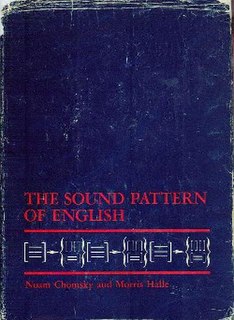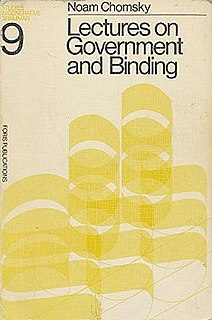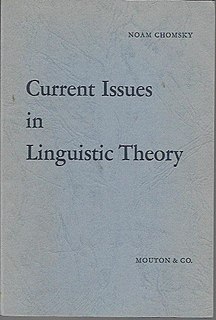
Avram Noam Chomsky is an American linguist, philosopher, cognitive scientist, historian, social critic, and political activist. Sometimes called "the father of modern linguistics", Chomsky is also a major figure in analytic philosophy and one of the founders of the field of cognitive science. He is a Laureate Professor of Linguistics at the University of Arizona and a Institute Professor Emeritus at the Massachusetts Institute of Technology (MIT), and is the author of more than 150 books on topics such as linguistics, war, politics, and mass media. Ideologically, he aligns with anarcho-syndicalism and libertarian socialism.
In linguistics, syntax is the study of how words and morphemes combine to form larger units such as phrases and sentences. Central concerns of syntax include word order, grammatical relations, hierarchical sentence structure (constituency), agreement, the nature of crosslinguistic variation, and the relationship between form and meaning. There are numerous approaches to syntax which differ in their central assumptions and goals.

The Sound Pattern of English is a 1968 work on phonology by Noam Chomsky and Morris Halle. It presents a view of the phonology of English, and has been very influential in both the field of phonology and in the analysis of the English language. Chomsky and Halle present a view of phonology as a linguistic subsystem, separate from other components of the grammar, that transforms an underlying phonemic sequence according to rules and produces as its output the phonetic form that is uttered by a speaker. The theory fits with the rest of Chomsky's early theories of language in the sense that it is transformational; as such it serves as a landmark in Chomsky's theories by adding a clearly articulated theory of phonology to his previous work which focused on syntax.
In linguistics, transformational grammar (TG) or transformational-generative grammar (TGG) is part of the theory of generative grammar, especially of natural languages. It considers grammar to be a system of rules that generate exactly those combinations of words that form grammatical sentences in a given language and involves the use of defined operations to produce new sentences from existing ones. The method is commonly associated with American linguist Noam Chomsky.
In linguistics, X-bar theory is a theory of syntactic category formation that was first proposed by Chomsky (1970) and further developed by Jackendoff (1977), along the lines of the theory of generative grammar put forth in the 1950s by Noam Chomsky. It attempts to capture the structure of phrasal categories with a single uniform structure called the X-bar schema, basing itself on the assumption that any phrase in natural language is an XP that is headed by a given syntactic category X. It played a significant role in resolving issues that phrase structure rules had, representative of which is the proliferation of grammatical rules, which is against the thesis of generative grammar.
John Thomas Grinder Jr. is an American linguist, author, management consultant, trainer and speaker. Grinder is credited with co-creating neuro-linguistic programming, with Richard Bandler. He is co-director of Quantum Leap Inc., a management consulting firm founded by his partner Carmen Bostic St. Clair in 1987. Grinder and Bostic St. Clair also run workshops and seminars on NLP internationally.
Deep structure and surface structure concepts are used in linguistics, specifically in the study of syntax in the Chomskyan tradition of transformational generative grammar.

Zellig Sabbettai Harris was an influential American linguist, mathematical syntactician, and methodologist of science. Originally a Semiticist, he is best known for his work in structural linguistics and discourse analysis and for the discovery of transformational structure in language. These developments from the first 10 years of his career were published within the first 25. His contributions in the subsequent 35 years of his career include transfer grammar, string analysis, elementary sentence-differences, algebraic structures in language, operator grammar, sublanguage grammar, a theory of linguistic information, and a principled account of the nature and origin of language.

Generative grammar, or generativism, is a linguistic theory that regards linguistics as the study of a hypothesised innate grammatical structure. It is a biological or biologistic modification of earlier structuralist theories of linguistics, deriving ultimately from glossematics. Generative grammar considers grammar as a system of rules that generates exactly those combinations of words that form grammatical sentences in a given language. The difference from structural and functional models is that the object is base-generated within the verb phrase in generative grammar. This purportedly cognitive structure is thought of as being a part of a universal grammar, a syntactic structure which is caused by a genetic mutation in humans.
In linguistics, the minimalist program is a major line of inquiry that has been developing inside generative grammar since the early 1990s, starting with a 1993 paper by Noam Chomsky.

Syntactic Structures is an influential work in linguistics by American linguist Noam Chomsky, originally published in 1957. It is an elaboration of his teacher Zellig Harris's model of transformational generative grammar. A short monograph of about a hundred pages, Chomsky's presentation is recognized as one of the most significant studies of the 20th century. It contains the now-famous sentence "Colorless green ideas sleep furiously", which Chomsky offered as an example of a grammatically correct sentence that has no discernible meaning. Thus, Chomsky argued for the independence of syntax from semantics.
Generative semantics was a research program in theoretical linguistics which held that syntactic structures are computed on the basis of meanings rather than the other way around. Generative semantics developed out of transformational generative grammar in the mid-1960s, but stood opposition to it. The period in which the two research programs coexisted was marked by intense and often personal clashes now known as the linguistics wars. Its proponents included Haj Ross, Paul Postal, James McCawley, and George Lakoff, who dubbed themselves "The Four Horsemen of the Apocalypse".
Sydney MacDonald Lamb is an American linguist and professor at Rice University, whose stratificational grammar is a significant alternative theory to Chomsky's transformational grammar. He has specialized in Neurocognitive Linguistics and a stratificational approach to language understanding.
Richard Milton Martin was an American logician and analytic philosopher. In his Ph.D. thesis written under Frederic Fitch, Martin discovered virtual sets a bit before Quine, and was possibly the first non-Pole other than Joseph Henry Woodger to employ a mereological system. Building on these and other devices, Martin forged a first-order theory capable of expressing its own syntax as well as some semantics and pragmatics, all while abstaining from set and model theory, and from intensional notions such as modality.
Ray C. Dougherty is an American linguist and was a member of the Arts and Science faculty at New York University until 2014 (retired). He received his bachelor's and master's degrees in engineering from Dartmouth College in the early 1960s and his Ph.D. in linguistics from the Massachusetts Institute of Technology in 1968. At MIT, Dougherty was one of the first students of Noam Chomsky, working in the field of transformational grammar. During the Linguistics Wars of the 1970s, Dougherty was a critic of the generative semantics movement. Specializing in computational linguistics, Dougherty has published several books and articles on the subject.
Merge is one of the basic operations in the Minimalist Program, a leading approach to generative syntax, when two syntactic objects are combined to form a new syntactic unit. Merge also has the property of recursion in that it may apply to its own output: the objects combined by Merge are either lexical items or sets that were themselves formed by Merge. This recursive property of Merge has been claimed to be a fundamental characteristic that distinguishes language from other cognitive faculties. As Noam Chomsky (1999) puts it, Merge is "an indispensable operation of a recursive system ... which takes two syntactic objects A and B and forms the new object G={A,B}" (p. 2).
This is a list of writings published by the American author Noam Chomsky.

Aspects of the Theory of Syntax is a book on linguistics written by American linguist Noam Chomsky, first published in 1965. In Aspects, Chomsky presented a deeper, more extensive reformulation of transformational generative grammar (TGG), a new kind of syntactic theory that he had introduced in the 1950s with the publication of his first book, Syntactic Structures. Aspects is widely considered to be the foundational document and a proper book-length articulation of Chomskyan theoretical framework of linguistics. It presented Chomsky's epistemological assumptions with a view to establishing linguistic theory-making as a formal discipline comparable to physical sciences, i.e. a domain of inquiry well-defined in its nature and scope. From a philosophical perspective, it directed mainstream linguistic research away from behaviorism, constructivism, empiricism and structuralism and towards mentalism, nativism, rationalism and generativism, respectively, taking as its main object of study the abstract, inner workings of the human mind related to language acquisition and production.

Lectures on Government and Binding: The Pisa Lectures (LGB) is a book by American linguist Noam Chomsky, published in 1981. It is based on the lectures Chomsky gave at the GLOW conference and workshop held at the Scuola Normale Superiore in Pisa, Italy in 1979. In this book, Chomsky presented his government and binding theory of syntax. It had great influence on the syntactic research in early 1980s, especially among the linguists working within the transformational grammar framework.

Current Issues in Linguistic Theory is a 1964 book by American linguist Noam Chomsky. It is a revised and expanded version of "The Logical Basis of Linguistic Theory", a paper that Chomsky presented in the ninth International Congress of Linguists held in Cambridge, Massachusetts in 1962. It is a short monograph of about a hundred pages, similar to Chomsky's earlier Syntactic Structures (1957). In Aspects of the Theory of Syntax (1965), Chomsky presents many of its ideas in a more elaborate manner.








